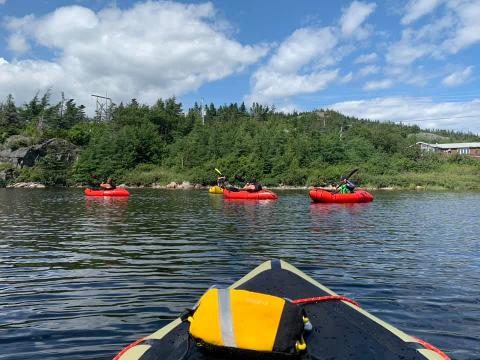Introduction to Packrafting



- Varighet: 7 Timer (ca.)
- Lokasjon: St. John's, NL
- Produktkode: PZ1REV
Summary
What is packrafting? Taken from the American Packrafting Association
Packrafting is basically a combination of backpacking and rafting, but people also use other modes of transportation, such as mountain bikes, to access lakes and rivers. “Packrafting” is using a small, lightweight inflatable boat to do whatever you would do in a bigger boat. By “small” we mean generally one person. By “lightweight” I mean less than ten pounds — generally five pounds or less. By “whatever a bigger boat can do,” I mean cross and float rivers, streams and lakes, even run rapids or cross saltwater bays and fjords. A packraft, easily carried while you walk, run, bike, hike, ski, drive, or even fly, encourages amphibious travel. Packrafts can be used to get into and out of otherwise hard to reach hunting, fishing, and climbing areas, or they can be used for “sport-boating,” paddled alongside kayaks and other whitewater craft on rapid-filled runs. But mostly they are as much fun to paddle as mountain bikes are to ride. They put joy into boating.
Introduction to Packrafting is a short program emphasizing safety, enjoyment and skill acquisition for entry-level individuals. This course applies to packrafts and inflatable kayaks, including traditional decked, non-decked, and self-bailing vessels. Boats will be paddled solo. We hold this course on calm, flat water, protected from wind, waves and outside boat traffic, with no apparent current and within swimming distance of shore.
Trip Details
We meet at 5C Golf Avenue in St. John's at 9am where we spend the morning learning core course content and packraft basics. Following a one hour lunch you will earn how inflate, pack, and paddle your Packraft on land. To finish off the day we will go for a paddle on a local pond where we will practice our new skills and learn rescue techniques.What's Included:
- Alpacka or Kokopelli packraft
- Wetsuit, PFD and other required
safety equipment.
What’s not included:
Gratuity (recommended)
Syllabus:
1) Personal Preparation
- Personal ability
- Swimming ability
- Water comfort and confidence
- Fitness, conditioning, and warm up
- Safe paddle and boat-handling
- Safety and rescue considerations
- Personal equipment
- In addition to learning hard skills, the importance of developing personal judgment and group responsibility increases on more difficult paddling venues
2) Getting Started
- Packing, carrying, storing, and inflating
- Launching, landing
- Posture, rocking, and balance
- Effective body usage
- Basic terminology of paddling equipment
3) Packraft Basics
- Types and parts: sizes, geometry, deck, combing, skirt, self-bailer, cargo zippers
- Outfitting: comfort, safety, entrapment hazards
- Outfitting: thigh straps, seat height and position, backrest, perimeter lines, tails, locking carabiners
- Spray skirt: grab loop!
- Stability
- Tracking
- Paddle: types, parts, length, and hand position
- Paddle leashes: flat vs. moving water
- Life jackets (PFDs): fit and regulations
- Appropriate clothing: comfortable/protective:
- Wet/dry suits
- Footwear
- Care of equipment:
- Packrafts
- Dry suits
- Other equipment
4) Packraft Repair: field repair techniques and materials
5) Packing of Equipment:
- Securing backpacks and other cargo to your boat·
- Entrapment
hazards
- Additional personal and group equipment
6) The Paddling Environment
- Wind
- Waves
- Weather
- Water
- Open water crossings
7) Strokes
- Stroke components: catch, propulsion, recovery, control and correction
- Safe and effective body usage
- Communication: signaling, with hand, paddle, whistle (Universal River Signals System)
- Types of strokes: power, turning:
- Forward
- Back (stopping)
- Draw
- Sculling draw/brace
- Sweep (including stern draw)
- Reverse sweep
- Rudder
- Low brace to avoid capsize
8) Safety & Rescue
All participants are to be asked to demonstrate a controlled capsize and an appropriate rescue.
- Water comfort and confidence
- Controlled capsize/wet exit
- Swim the boat to shore (short distance)
- Emptying a packraft
- Deep water exit/re-entry
- Assisted Rescues/re-entry
- Responding to sudden deflation (popped boat or accidental cargo fly opening)
- From boat:
- Bulldozing
- Towing Maneuvers
- Spin: boat pivots in place
- Abeam: boat moves sideways without headway
- Forward: boat goes forward in a reasonably straight line
- Stopping: boat stops within a reasonable distance





